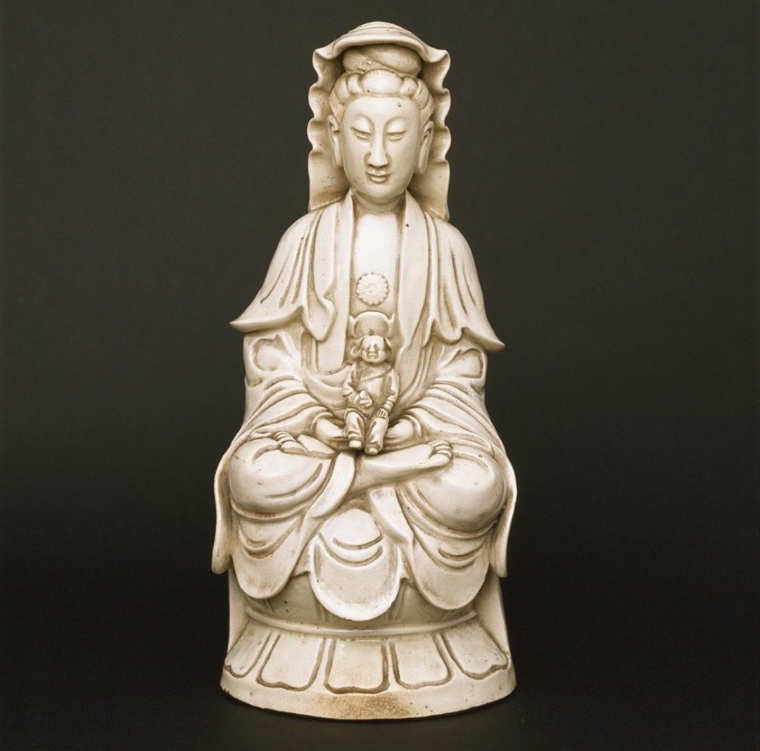
“Love the Immaculate.”
— St. Maximilian Maria Kolbe
Titles of Our Lady in Japan
Maria Kannon
During the Great Persecution, Kakure Kirishitan (hidden Christians), mostly in the Nagasaki area, also created statues of the Blessed Virgin Mary with child, disguised as the Buddhist deity Kannon (Goddess of Mercy). These images called “Maria Kannon” were made or altered to look like Kannon, but they were not worshiped as Kannon. Instead, the Kakure Kirishitans venerated these Buddhist statues by silently praying to the Blessed Virgin Mary. Many statues, moreover, had a Christian icon hidden inside the body or camouflaged in the artwork. During the dark years of the persecution, these secretive methods fooled government agents and helped the Christians to keep their faith hidden and alive. Our Lady was with them the whole time.
The Virgin of Tsuwano
The Hidden Christians who suffered during the Great Persecution are remembered with great respect. Our Lady appeared to some Kakure Kirishitan while they were being tortured in 1867. Young Yasutaro's story is one of them. Locked in a small cage, instead of renouncing his faith, he died smiling, comforted by the Blessed Virgin Mary.
JAPAN Japan celebrates the Virgin of Tsuwano, who brought comfort to martyrs (asianews.it)
Our Lady of Miyako
Father Leo Robin, a French Priest, had heard about the Japanese martyrs and deeply admired them. He started a devotional group that prayed for the conversion of the Japanese people and to end the Great Christian Persecution.
He commissioned six statues to be made of the Blessed Virgin Mary and had them blessed by Pope Pius IX. One of these statues was brought to Japan. A boy was instructed to carry it up a mountain and bury it facing the city of Miyako (present day Kyoto). With the help of the prayers and Our Lady, the edict forbidding Christianity in Japan was abolished.
Today the statue is encased for veneration in the basement Chapel of the Kawaramachi Catholic Church in Kyoto.
Seibo Maria (Holy Mother) of the Discovery of the Hidden Christians
Under the Great Persecution in Japan, Christianity had survived underground for over 250 years. On March 17, 1865, a small group of Kakure Kirishitans (hidden Christians) entered the newly constructed and consecrated Oura Church (now Oura Cathedral) in Nagasaki. They asked the French priest, Father Petitjean, who was praying his noon prayers at the time, to see the statue of Santa Maria. This same statue shown to them of Seibo Maria (Holy Mother) remains in Oura Cathedral commemorating this great day. The Kakure Kirishitans had held onto their beliefs in Our Lady throughout the centuries and She maternally protected them.
The Virgin Mary of Japan
The Virgin Mary of Japan stands outside the Oura Cathedral in Nagasaki. This white marble statue, which commemorates the Shimabara Rebellion, was imported from France.
The Shimabara Rebellion took place in 1638. 37,000 Catholic Christians, mostly women and children, were murdered during a Catholic Christian uprising against their oppressive Feudal Lord at Hara Castle.
Hibaku no Maria (Atomic-Bombed Mary)
A wooden statue of Our Lady was badly burned during the bombing of Nagasaki on August 9, 1945. The epicenter of the bomb was right over the Urakami Cathedral, which was home to the statue. When the bomb exploded, 3 priests were hearing confessions and 30 Catholics were inside praying the rosary. The Cathedral was the only partial standing structure in the area after the bombing. The statue miraculously did not burn completely - Our Lady’s head remained, found under the rubble.
This portion of the statue is now placed in a side chapel at the Urakami Cathedral in remembrance of the tragedy that happened on that day.
Our Lady of Akita
This approved Marian apparition of the Catholic Church took place in Akita, Japan, in a Catholic Convent named Seitai Hoshikai. Between 1973 and 1981, Sister Agnes Sasagawa received messages from Our Lady. The messages warned of impending doom to mankind because of unrepentant sinners and Our Lady asked everyone to pray the rosary.
Unusual and miraculous phenomena also happened during this time. Sister Agnes was healed miraculously and the statue of Our Lady bled and shed tears. Watch a short video to learn more. Sister Agnes tells her story first hand.
Holy Mary Kannon of Hara Castle
Unveiled in March 2023, Holy Mary Kannon of Hara Castle is the largest wooden statue of Our Lady in the world. She stands almost 33 feet high. Situated on the foothills of Mount Unzen, overlooking the Hara Castle Ruins, Holy Mary Kannon was sculpted to console the 37,000 victims who died there during the Shimabara Rebellion. Christian men, women, young and old who were led by boy-saint Amakusa Shiro to rebel against their oppresive government, were in turn brutely murdered.
Scupture artist, Eiji Oyamatsu, was inspired by Saint Pope John Paul II’s visit to Japan in 1981. Oyamatsu made a smaller prototype statue, sent it to the Pope with his plans for a larger one. Saint Pope John Paul II blessed his work efforts. 40 years later the beautiful sculpture was completed and now is a place of pilgrimage and veneration.







